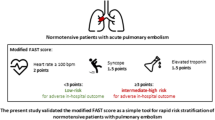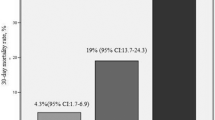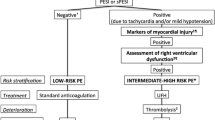Abstract
To compare the prognostic accuracy of the 2014 risk model of the European Society of Cardiology (ESC) and of Bova and TELOS scores for identification of normotensive patients with pulmonary embolism (PE) at high risk for short-term adverse events (i.e., intermediate–high risk patients), we retrospectively applied these tests to a prospective cohort of 994 normotensive patients with objectively confirmed PE. Sixty-three (6.3 %) patients reached the primary outcome, a composite of hemodynamic collapse and death within 7 days from diagnosis. The Bova and TELOS scores classified the same proportion of patients in intermediate–high risk category (5.9 and 5.7 %, respectively), with a similar primary outcome rate (18.6 and 21.1 %, respectively). The 2014 ESC model classified in the intermediate–high risk category the largest proportion of patients (12.5 %, p < 0.001 vs Bova and TELOS), with the lowest primary outcome rate (13 %, p = ns vs Bova and TELOS). When lactate determination was added to the Bova score, 112 patients (11.2 %) were classified in the intermediate–high risk category (p < 0.05 vs Bova and TELOS), with a slight increase in the primary outcome rate (25.9 %, p = 0.014 vs 2014 ESC model), allowing the recognition of a twofold higher number of patients reaching the primary outcome (29 vs 15, 11 and 12 patients in the 2014 ESC model, Bova and TELOS scores, respectively, p < 0.01 for all). The 2014 ESC model, Bova and TELOS scores identify a small number of intermediate–high risk patients with PE, without differences among tests. Adding plasma lactate to the Bova score significantly improves the identification of intermediate–high risk patients.



Similar content being viewed by others
Abbreviations
- CI:
-
Confidence interval
- ESC:
-
European Society of Cardiology
- HR:
-
Heart rate
- IQR:
-
Inter-quartile rage
- PE:
-
Pulmonary embolism
- PESI:
-
Pulmonary Embolism Severity Index
- RV:
-
Right ventricular
- SBP:
-
Systolic blood pressure
- SD:
-
Standard deviation
- sPESI:
-
Simplified Pulmonary Embolism Severity Index
- TELOS:
-
Thrombo-embolism lactate outcome study
References
Grifoni S, Olivotto I, Cecchini P et al (2000) Short-term clinical outcome of patients with acute pulmonary embolism, normal blood pressure, and echocardiographic right ventricular dysfunction. Circulation 101:2817–2822
Binder L, Pieske B, Olschewski M, Geibel A, Klostermann B, Reiner C, Konstantinides S (2005) N-terminal pro-brain natriuretic peptide or troponin testing followed by echocardiography for risk stratification of acute pulmonary embolism. Circulation 112(11):1573–1579
Pieralli F, Olivotto I, Vanni S, Conti A, Camaiti A, Targioni G, Grifoni S, Berni G (2006) Usefulness of bedside testing for brain natriuretic peptide to identify right ventricular dysfunction and outcome in normotensive patients with acute pulmonary embolism. Am J Cardiol 97(9):1386–1390
Becattini C, Vedovati MC, Agnelli G (2007) Prognostic value of troponins in acute pulmonary embolism: a meta-analysis. Circulation 116(4):427–433
Meyer G, Vicaut E, Danays T et al (2014) PEITHO Investigators. Fibrinolysis for patients with intermediate-risk pulmonary embolism. N Engl J Med 370:1402–1411
Aujesky D, Obrosky DS, Stone RA, Auble TE, Perrier A, Cornuz J, Roy PM, Fine MJ (2005) Derivation and validation of a prognostic model for pulmonary embolism. Am J Respir Crit Care Med 172(8):1041–1046
Jiménez D, Aujesky D, Moores L et al. (2010) Simplification of the Pulmonary Embolism Severity Index for prognostication in patients with acute symptomatic pulmonary embolism. Arch Intern Med 170:1383–1389
Konstantinides SV, Torbicki A, Agnelli G et al (2014) Guidelines on the diagnosis and management of acute pulmonary embolism: the Task Force for the Diagnosis and Management of Acute Pulmonary Embolism of the European Society of Cardiology. Eur Heart J 35:3033–3080
Becattini C, Agnelli G, Lankeit M et al (2016) Acute pulmonary embolism: external validation of the 2014 risk stratification model of the European Society of Cardiology. Eur Resp J [Epub ahead of print] PMID:27174887
Bova C, Sanchez O, Prandoni P et al (2014) Identification of intermediate-risk patients with acute symptomatic pulmonary embolism. Eur Respir J 44:694–703
Fernàndez C, Bova C, Sanchez O et al (2015) Validation of a model for identification of patients at intermediate to high risk for complications associated with acute symptomatic pulmonary embolism. Chest 148:211–218
Jones AE, Shapiro NI, Trzeciak S et al (2010) Emergency Medicine Shock Research Network (EMShockNet) Investigators: Lactate clearance vs central venous oxygen saturation as goals of early sepsis therapy: a randomized clinical trial. JAMA 303:739–746
Lavery RF, Livingston DH, Tortella BJ et al (2000) The utility of venous lactate to triage injured patients in the trauma center. J Am Coll Surg 190:656–664
Vanni S, Viviani G, Baioni M et al (2013) Prognostic value of plasma lactate levels among patients with acute pulmonary embolism: the thrombo-embolism lactate outcome study. Ann Emerg Med 61:330–338
Vanni S, Socci F, Pepe G et al (2011) High plasma lactate levels are associated with increased risk of in-hospital mortality in patients with pulmonary embolism. Acad Emerg Med 18:830–835
Vanni S, Jimènez D, Nazerian P et al (2015) Short-term clinical outcome of normotensive patients with acute PE and high plasma lactate. Thorax 70:333–338
Vanni S, Polidori G, Vergara R et al (2009) Prognostic value of ECG among patients with acute pulmonary embolism and normal blood pressure. Am J Med 122:257–264
Hosmer DW, Lemeshow S (2000) Applied logistic regression, 2nd edn. John Wiley & Sons Inc, New York
Efron B, Tibshirani RJ (1998) An introduction to the bootstrap. Chapman & Hall/CRC Press, New York
Steyerberg EW, Harrell FE Jr, Borsboom GJ et al (2001) Internal validation of predictive models. J Clin Epidemiol 54:774–781
Torbicki A, Perrier A, Konstantinides S et al (2008) ESC Committee for Practice Guidelines (CPG). Guidelines on the diagnosis and management of acute pulmonary embolism: the Task Force for the Diagnosis and Management of Acute Pulmonary Embolism of the European Society of Cardiology (ESC). Eur Heart J 29:2276–2315
Grifoni S, Vanni S, Magazzini S et al (2006) Association of persistent right ventricular dysfunction at hospital discharge after acute pulmonary embolism with recurrent thromboembolic events. Arch Intern Med 166:2151–2156
Kucher N, Goldhaber SZ (2003) Cardiac biomarkers for risk stratification of patients with acute pulmonary embolism. Circulation 108:2191–2194
Jiménez D, Aujesky D, Moores L et al (2011) Combinations of prognostic tools for identification of high-risk normotensive patients with acute symptomatic pulmonary embolism. Thorax 66:75–81
Vanni S, Nazerian P, Pepe G et al (2011) Comparison of two prognostic models for acute pulmonary embolism: clinical vs. right ventricular dysfunction-guided approach. J Thromb Haemost 9:1916–1923
Lankeit M, Friesen D, Schafer K, Hasenfuß G, Konstantinides S, Dellas C (2013) A simple score for rapid risk assessment of non-high-risk pulmonary embolism. Clin Res Cardiol 102:73–80
Jiménez D, Kopecna D, Tapson V et al (2014) PROTECT investigators. Derivation and validation of multimarker prognostication for normotensive patients with acute symptomatic pulmonary embolism. Am J Respir Crit Care Med 189:718–726
Sanchez O, Trinquart L, Planquette B et al (2013) Echocardiography and Pulmonary Embolism Severity Index have independent prognostic roles in pulmonary embolism. Eur Respir J 42:681–688
Vedovati MC, Becattini C, Agnelli G, Kamphuisen PW, Masotti L, Pruszczyk P, Casazza F, Salvi A, Grifoni S, Carugati A, Konstantinides S, Schreuder M, Golebiowski M, Duranti M (2012) Multidetector CT scan for acute pulmonary embolism: embolic burden and clinical outcome. Chest 142:1417–1424
Author information
Authors and Affiliations
Corresponding author
Ethics declarations
Conflict of interest
The authors declare that they have no conflict of interest.
Statement of human and animal rights
The study was approved by the Istitutional Review Board.
Informed consent
Written informed consent was obtained for inclusion in each study.
Rights and permissions
About this article
Cite this article
Vanni, S., Nazerian, P., Bova, C. et al. Comparison of clinical scores for identification of patients with pulmonary embolism at intermediate–high risk of adverse clinical outcome: the prognostic role of plasma lactate. Intern Emerg Med 12, 657–665 (2017). https://doi.org/10.1007/s11739-016-1487-6
Received:
Accepted:
Published:
Issue Date:
DOI: https://doi.org/10.1007/s11739-016-1487-6




